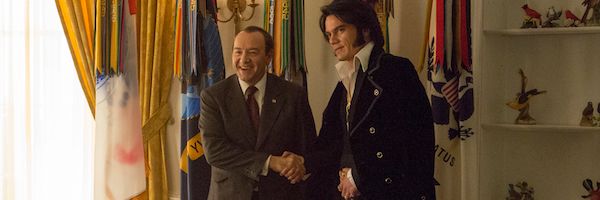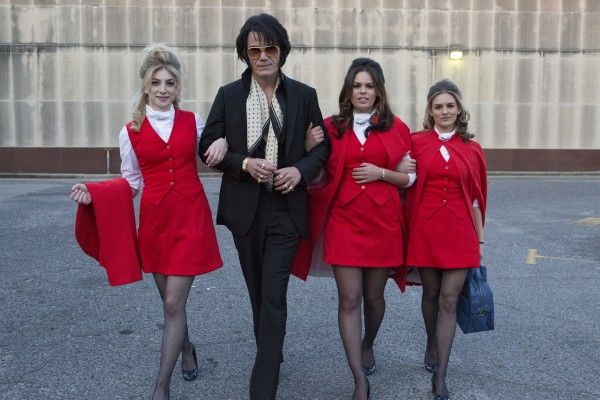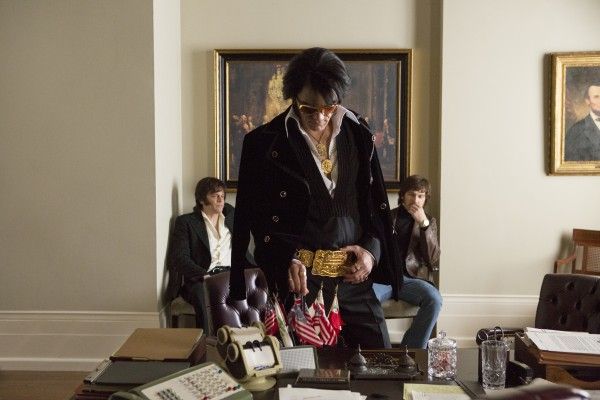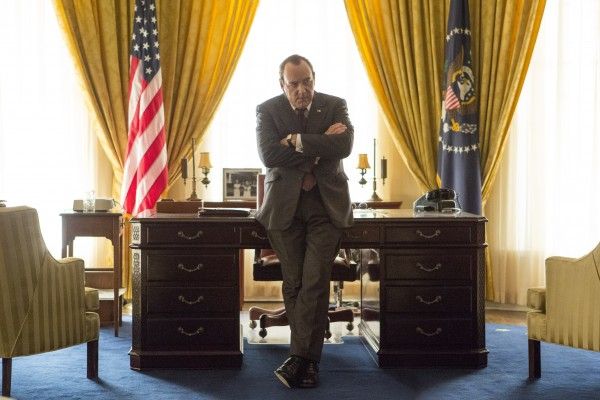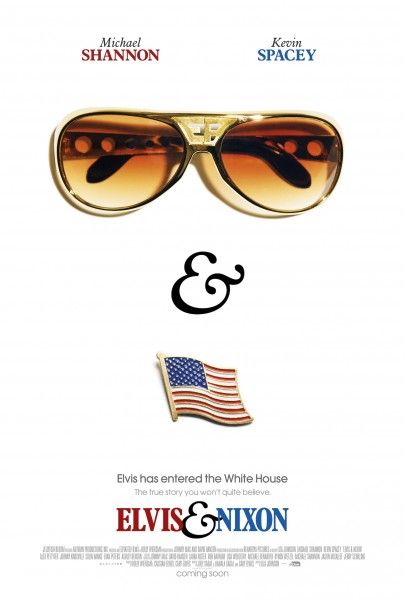Elvis & Nixon concerns the one time meeting between Elvis Presley and the pre-Watergate President Richard M. Nixon. The meeting occurred in 1970, but was not publicly known until 1972. Photos exist. Presley’s hand in Nixon’s, locked in a firm handshake; flags stood behind the two and Presely’s gold International Championship belt and wavy-swept hair somehow displayed more power than the Oval Office was able to in his presence (i.e. party in the front, business in the back). One particular picture is the most requested photo in the history of the National Archives.
The public interest in the photo has more to do with two men who had absolute power in different realms, because those realms seem so separate they’d never seem to intersect. Sure, a Hollywood star in a suit might be at a fundraiser for a US president, but not in the Oval Office, and not with gold chains, a deep V shirt, a knockoff boxing belt. There is of course a reason why Presley was there. And it’s strange. Presley wanted to receive an agent at-large undercover narcotics badge so that he could arrest disrespectful elements in the name of the FBI—people who the King thought were disrespecting America in protest of the Vietnam War and its legacy of decency. Nixon’s staff took the meeting that Presley requested, thinking a photo could go a long way in showing the approachability and appeal of the President.
The strangeness in the meeting request is what Liza Johnson’s film is mostly concerned with. But the only area where Elvis & Nixon actually gels is the extended period where Presley (Michael Shannon) and Nixon (Kevin Spacey) get to trade wits and wisdom as men of power. There is too much lead up to their meeting. I understand the desire to get to the question of why did this meeting happen?, but Elvis has the opportunity to sell Nixon on that in the room. Johnson’s film races through a bunch of back-story involving Presley’s associate, Jerry Schilling (Alex Pettyfer) who left Memphis for a job in Hollywood on the Paramount studio lot. Jerry is trying to have a normal life, get married, and not be pulled back in by the allure of Presley’s promises as he accompanies Presley to help get him badge meetings in Washington, D.C.
Jerry is important to the story, but in trying to blow up that one photo, the canvas gets large enough that it rambles seemingly forever before we get to the event we want to see: Elvis and Nixon discussing their similarities and differences. When Elvis and Nixon do finally meet, and the obnoxious sitcom styled musical score no longer pulls us along with jangled promises of wackiness, the film slows, and the actors we want to see act against one another get to do just that.
There’s a compelling story inside and just outside of the Oval Office. It’s a pop star and a President who can’t comprehend the shifts in America because they were both busy building an empire that got them into Graceland and into the White House. Their work ethic and family background are divergent, yet familiar. And it’s also in the inner-workings of their support staff (Colin Hanks and Evan Peters for Nixon; Pettyfer and Johnny Knoxville for Presley), who attempt to uphold the absurd rules of both—because they like the access provided by being approximate to absolute power. After all, with great power comes the responsibility of making sure no one else drinks your boss’ daily soda or sits down before they do.
Shannon and Spacey, visually, are miscast but are nonetheless great. Shannon, who never directs his Elvis-isms directly at the camera, makes Elvis’ trademark hand and hip movements feel organic and everyday—not like a gimmick. And he gets a few solid monologues as he practices his introduction before meeting the President that allows us to see a side of the King we haven’t seen before. On the opposite side, it takes a bit longer for Spacey to move out of Nixon body-and-voice imitation mode (for which, of course, Spacey is well known for his great mimicry) and imbue his own read on the material. But when he does, Spacey’s a nice match for Shannon.
Because the meeting in the Oval Office is so delightful, it’s unfortunate that all the satellite stories were also put into orbit (aided again by a SNL parody-worthy swingin' score). In addition to tacking on Jerry’s will-he-make-it-home-in-time-to-meet-his-girlfriend’s-father plot line, there are also a few too many attempts to inject Elvis iconic moments (i.e. Elvis shot his television set four years after the events in this film). Elvis had a very long career and this is a very particular moment in it. Having him eat donuts with (and win over) black people who call him a thief has more to do with directly addressing modern commentary about appropriation, and has very little to do with the story in question, unless it’s spun into Elvis’ idea that America is too fractured to function.
Despite some great moments between Shannon and Spacey, Elvis & Nixon suffers from a lack of simplicity. It’s easy to understand why people love the unexpected image of Elvis and Nixon being together in the highest office in the land. After watching Elvis & Nixon, I still want more of that. In a turn of a future presidential phrase: it’s the meeting, stupid.
Grade: C
Elvis & Nixon premiered at the Tribeca Film Festival and opens in select cities this Friday, April 22.

